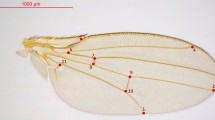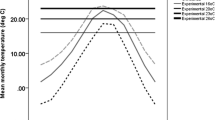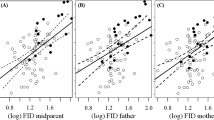Abstract
Two strains ofDrosophila melanogaster were selected for anemotactic response for six generations—one line for upwind response and one line for downwind response. A realized heritability estimate ofh 2=0.131 ±0.029 was obtained for the upwind response, and a realized heritability estimate ofh 2=0.012±0.014 was obtained for the downwind response. The divergent selection estimate wash 2=0.031±0.013. These values are consistent with previously reported heritability estimates for phototaxis and geotaxis, and serve to suggest that wind-oriented movement can be rapidly modified by selection under different habitat conditions. A comparison of wind response among wild-caught individuals of 11 species shows significant response differences between closely related species. Evaluation of these differences in light of the ecology of the flies suggests that upwind movement occurs among the monophagous species, which must move long distances to find their specific feeding sites, while downwind movement is more typical of polyphagous species. Species which are found in riparian or montane forest conditions showed a general reluctance to move under windy conditions. This corresponds to previous observations on these species and reflects the absence of wind generally encountered by these species during their natural periods of activity.
Similar content being viewed by others
References
Dobzhansky, Th., and Powell, J. R. (1974). Rates of dispersal ofDrosophila pseudoobscura and its relatives.Proc. Roy. Soc. Lond. B 187:281–298.
Dobzhansky, R., and Spassky, B. (1969). Artificial and natural selection for two behavioral traits inDrosophila pseudoobscura.Proc. Natl. Acad. Sci. USA 62:75–80.
Dobzhansky, Th., and Wright, S. (1943). Genetics of natural populations. X. Dispersion rates inD. pseudoobscura.Genetics 28:304–340.
Dobzhansky, Th., Powell, J. R., Taylor, C. E., and Andregg, M. (1978). Ecological variables affecting the dispersal behavior ofD. pseudoobscura and its relatives.Am. Nat. 114:325–334.
Endler, J. A. (1977). Geographic Variation, Speciation and Clines, Princeton University Press, Princeton, N.J.
Falconer, D. (1960).Introduction to Quantitative Genetics, Ronald Press, New York.
Heed, W. B., and Heed, S. R. (1972). Ecology, weather, and dispersal of Drosophila on an island mountain.Dros. Inform. Serv. 48:100.
Hill, W. (1972). Estimation of realized heritabilities from selection experiments. I. Divergent selection.Biometrics 28:247–765.
Johnson, C. G. (1969).Migration and Dispersal of Insects by Flight, Methuen, London.
Johnston, J. S. (1978). Dispersal behavior and biological control of insects. In Richardson, R. H. (ed.),The Screwworm Problem: Evolution of Resistance to Biological Control, University of Texas Press, Austin.
Johnston, J. S. and Heed, W. B. (1971). A comparison of banana and rotted cactus as a bait for desertDrosophila.Dros. Inform. Serv. 46:96.
Johnston, J. S. and Heed, W. B. (1976). Dispersal of desert-adaptedDrosophila: The saguaro-breedingD. nigrospiracula.Am. Nat. 110:129–651.
Kellogg, F. E., Frizel, D. E. and Wright, R. H. (1962). The olfactory guidance of flying insects. IV.Drosophila.The Cand. Entomol. 94:884–888.
Lerner, I. M. (1954).Genetic Homeostasis, Wiley, New York.
Markow, T. A. (1975). A genetic analysis of phototactic behavior inDrosophila melanogaster. I. Selection in the presence of inversions.Genetics 79:527–534.
Medioni, J. (1962). Contribution a l'etude psycho-physiologique et genetique du phototropisme d'un insecteDrosophila melanogaster.Meigen. Bull. Psychol. Paris 16(2):8.
Narise, T. (1966). The mode of migration ofDrosophila ananassae under competitive conditions. In Wheeler, M. R. (ed.),Studies in Genetics, Vol. III, University of Texas, Austin.
Parsons, P. A. (1975). Phototactic responses along a gradient of light intensities for the sibling speciesDrosophila melanogaster andDrosophila simulans.Behav. Genet. 5:17–25.
Parsons, P. A. (1978). Habitat selection and evolutionary strategies inDrosophila: An invited address.Behav. Genet. 8:511–526.
Powell, J. R., Dobzhansky, Th., Hook, J. E., and Wistrand, H. (1976). Genetics of natural populations. XLIII. Further studies on rates of dispersal ofDrosophila pseudoobscura and its relatives.Genetics 82:293–506.
Richardson, R. H., and Johnston, J. S. (1975). Behavioral components of dispersal inDrosophila mimica.Oecologia 20:287–299.
Richardson, R. H., Kojima, K., and Lucas, H. L. (1968). An analysis of short term selection experiments.Heredity 23:493–506.
Taylor, C. E., and Powell, J. R. (1978). Habitat choice in natural populations ofDrosophila.Oecologia 37:69–75.
Watanabe, T. K., and Anderson, W. W. (1976). Selection for geotaxis inDrosophila melanogaster: Heritability, degree of dominance, and correlated responses to selection.Behav. Genet. 6:71–86.
Wright, R. H. (1966). Some quantitative aspects of insect attraction.Can. Entomol. 98:1114–1117.
Author information
Authors and Affiliations
Additional information
This work was supported in part by NSF Grant DEB 76-19829 to J.S.J.
Rights and permissions
About this article
Cite this article
Johnston, J.S. Genetic variation for anemotaxis (wind-directed movement) in laboratory and wild-caught populations ofDrosophilia . Behav Genet 12, 281–293 (1982). https://doi.org/10.1007/BF01067848
Received:
Accepted:
Issue Date:
DOI: https://doi.org/10.1007/BF01067848




